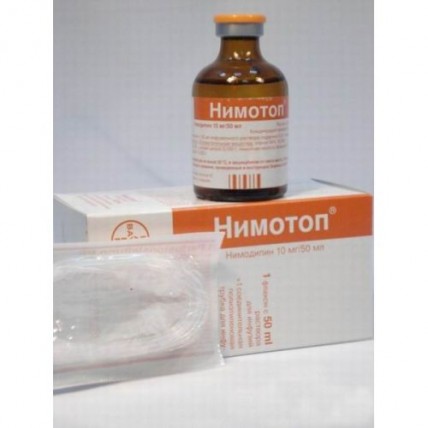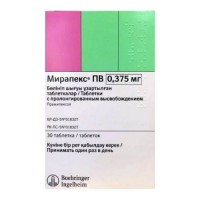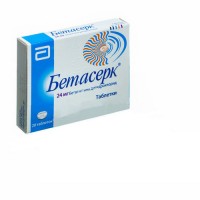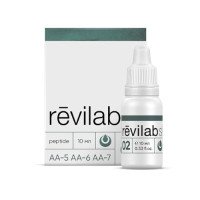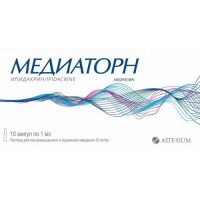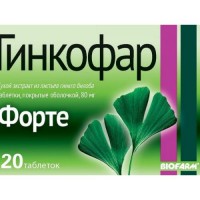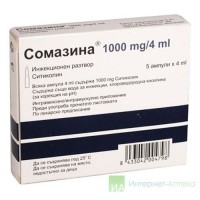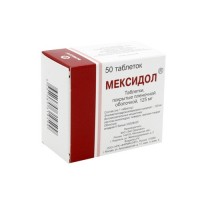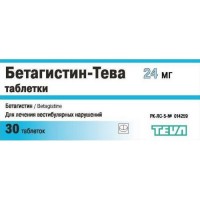Nimotop 10 mg / 50 ml solution for infusion 1's
- $48.30
Out Of Stock
The instruction for medical use of Nimotop® medicine the Trade name of Nimotop® the International unlicensed name Nimodipin Lekarstvennaya a form Solution for infusions, 10 mg / 50 ml Structure of 50 ml of solution contain active agent - nimodipin 0.010 g, excipients: alcohol of 96%, a macrogoal 400, sodium citrate, citric acid, water for injections. The description Transparent solution, slightly yellowish color Pharmacotherapeutic group Drugs for treatment of diseases of a cardiovascular system. Blockers of slow calcium channels. Blockers of slow calcium channels selection. Dihydropyridinic derivatives. Nimodipin the ATX C08CA06 Code the Pharmacological Pharmacokinetics Absorption At properties continuous intravenous administration of 0.03 mg/kg/h average equilibrium concentration in blood plasma reach 17.6-26.6 ng/ml. After intravenous jet administration the concentration of a nimodipin in blood plasma decreases dvukhfazno, with elimination half-life of 5-10 minutes and about 60 minutes. Distribution volume at intravenous administration (Vss, two-phase model) is 0.9-1.6 l/kg of body weight, the general (system) clearance is 0.6-1.9 l/h/kg. Linking with proteins of Nimodipin plasma for 97-99% contacts proteins of blood plasma. Nimodipin gets through a placental barrier in the researches in Vivo. Despite the absence of data, at people it is possible to assume penetration of drug through a placental barrier too. In the researches in Vivo in milk authentically higher came to light, than in plasma, concentration of a nimodipin and/or its metabolites. In breast milk of women nimodipin was defined in the concentration comparable to concentration in blood plasma. Nimodipin can be defined in cerebrospinal liquid in the concentration making about 0.5% of concentration in blood plasma which in general are equivalent to concentration of free substance in blood plasma. Metabolism Nimodipin is removed in the metabolic way with participation of enzymes of a system of P450 3A4 cytochrome, mainly, by dehydrogenation of a dihydropyridinic ring and oxidizing splitting of ether. Oksilitelny splitting of ether, hydroxylation of 2- and 6-methyl groups and a glyukuronization as conjugation test, are additional important stages of metabolism. Three main metabolites defined in blood plasma do not possess, or have insignificant residual therapeutic activity. Existence of the inducing or inhibiting influence on enzymes of a liver is not known. At people the metabolites are removed with a speed about 50% through kidneys and about 30% with bile. Elimination kinetics linear. Elimination half-life of a nimodipin is in limits 1.1-1.7 hours. Terminal elimination half-life, equal 5-10 hours, does not represent the importance in respect of influence on a dosing interval. An average progression of concentration of a nimodipin in plasma after intravenous infusion of 0.015 mg/kg within one hour (n=24, older persons). Bioavailability Due to the high speed of metabolism at the first passing through a liver (85-95%), the absolute bioavailability of a nimodipin is 5-15%. Removal it is not revealed the inducing or inhibiting activities of enzymes of a liver. Removal of metabolites at the person is carried out for 50% by kidneys and for 30% through biliary tract. The kinetics of removal is linear. Elimination half-life of a nimodipin makes from 1.1 to 1.7 hours. Terminal elimination half-life of 5-10 hours is not relevant so to influence an interval between intake of medicine. The pharmacodynamics Nimodipin is an antagonist of calcium channels of 1.4-dihydropyridinic group. Due to high lipophilicity active agent well gets through a blood-brain barrier. During preclinical trials it was established what nimodipin, being high-affine and selection to calcium channels of L-type, thus, blocks transmembrane intake of calcium in cells. At the morbid conditions connected with the increased receipt of calcium ions in neurons, for example, in brain ischemia, assume what nimodipin improves their stability and functioning. Ischemic neurologic disturbances and mortality at patients with subarachnoidal hemorrhage at use of a nimodipin considerably decrease. Indications - prevention and treatment of the ischemic neurologic disorders caused by a brain angiospasm against the background of subarachnoidal hemorrhage owing to a rupture of aneurysm the Route of administration and doses Is recommended to observe the following mode of dosing: At the beginning of therapy within 2 hours about 1 mg of drug (5 ml of solution) an hour is entered that approximately makes 15 mkg/kg/h. At good tolerance (first of all, in the absence of the profound lowering of arterial pressure), in 2 hours the dose is increased to 2 mg of a nimodipin (10 ml of solution) an hour that approximately makes 30 mkg/kg/h. The initial dose for patients weighing much below 70 kg or with labile arterial blood pressure has to make 0.5 mg of a nimodipin (2.5 ml of solution) an hour. Instillation during surgical intervention the freshly cooked Nimotopa® solution (1 ml of Nimotop® infusion solution and 19 ml of Ringera solution) which is warmed up to body temperature can intratsisternalno be entered into brain tanks. Solution needs to be used right after preparation. After the termination of a course of infusional therapy lasting 5-14 days, oral administration of the tablets Nimotop® on 2 tablets of 6 times a day (6 x 60 mg of a nimodipin) is recommended. At patients with undesirable effects the dose of drug can be reduced or treatment can be stopped. Dose adjustment at the combined use with the drugs inhibiting or inducing the system of P450 3A4 cytochrome can be required. Patients with a liver failure At patients with a heavy liver failure, in particular with cirrhosis, the bioavailability of a nimodipin can be increased due to decrease in effect of the first passing and decrease in metabolic clearance. And also undesirable effects, such as hypotension, this category of patients can have more expressed effects. In such cases it is necessary to lower a dose or, if necessary, to consider a question of the therapy termination. Children's and teenage age Safety and efficiency of use of Nimotopa® for children and teenagers aged up to 18 years is not established. Patients at whom the volume overload is undesirable or contraindicated can enter Nimotopa® infusion solution through a catheter into the central vein, without additional solution for infusions. Nimotopa® infusion solution is applied to continuous intravenous administration through the central catheter with use of the infusional pump. Tubes of a catheter are connected among themselves to the help of the three-running crane. Mixing of Nimotop® solution with other medicines or addition in an infusional vessel or a bottle is not allowed. Perhaps simultaneous introduction with one of the following solutions: 5% of glucose, 0.9% of sodium of chloride, Ringera with a lactate, Ringera with a lactate and magnesium, a dextran 40, hydroxyethylated (weed (Au-2-hydroxyethyl)) starch of 6%, human 5% of albumine or blood. According to results of dodklinichesky researches, Mannitolum can also be entered at the same time during till 24 o'clock. The Nimotop® solution ratio to other solution for simultaneous infusion has to make 1:4. It is also recommended to continue introduction of a nimodipin during anesthesia, surgical interventions and an angiography. Use for the purpose of prevention Intravenous administration of Nimotop® solution should be begun no later than in 4 days after hemorrhage, and to continue during the entire period of the maximum risk of developing a vasospasm, that is up to 10-14 days after subarachnoidal hemorrhage. If during preventive use of Nimotop® solution it is made surgical treatment of the cause of hemorrhage, intravenous therapy by drug it is necessary to continue at least within 5 days after surgery. After the termination of a course of infusional therapy, during the next 7 days the oral administration of the tablets Nimotop® in a dose of 60 mg x 6 times a day at an interval of the 4th hour is recommended. Use with the medical purpose If the ischemic neurologic disturbances caused by a vasospasm after subarachnoidal hemorrhage already take place, it is necessary to appoint infusional therapy as soon as possible and to carry out within not less than 5 days, but no more than 14 days. After the termination of a course of infusional therapy, during the next 7 days the oral administration of the tablets Nimotop® in a dose of 60 mg x 6 times a day (each 4 hours) is recommended. If against the background of therapy by Nimotop® solution it is made surgical treatment of the cause of hemorrhage, intravenous therapy by drug it is necessary to continue at least within 5 days after surgery. Side effects are provided Further the undesirable effects observed in clinical trials (placebo - controlled researches: nimodipin n=703, n=692 placebo, uncontrollable researches: nimodipin n=24964, date 31.08.2005) CIOMS III frequencies are categorized. Within each group of frequency the undesirable effects are distributed as decrease in gravity. Infrequently (& gt, 1/1000 and & lt, 1/100) - thrombocytopenia - allergic reactions, rash - a headache - tachycardia - arterial hypotension, a vazodilatation - nausea Seldom (& gt, 1/10000 and & lt, 1/1000) - bradycardia - intestinal impassability - tranzitorny increase in level of liver enzymes - reactions on the place of an injection and infusion, thrombophlebitis in the place of infusion of the Contraindication - hypersensitivity to a nimodipin or excipients - the persons having alcoholism, epilepsy - pregnancy and the period of a lactation - a liver disease - children's and teenage age up to 18 years Medicinal interactions Fluoxetine the Combined use of a nimodipin and antidepressant of fluoxetine is followed by increase in a kontsetration of a nimodipin in blood plasma for 50%, at the same time concentration of fluoxetine considerably decreases, and concentration of its active metabolite of a norfluoksetin does not change. Nortriptilin leads Simultaneous use of a nimodipin and nortriptilin to small decrease in exposure of a nimodipin in an equilibrium state without change of concentration of a nortriptilin in blood plasma. Rifampicin As a matter of experience of use of other antagonists of calcium is expected that rifampicin accelerates metabolic splitting of a nimodipin by means of induction of activity of enzymes and, in fact, considerably to reduce efficiency of a nimodipin at their simultaneous use. Therefore combined use of Nimotopa® and rifampicin contraindicated. At simultaneous use of a nimodipin and the following inhibitors of a system of P450 3A4 cytochrome it is necessary to control arterial blood pressure and if necessary to korrigirovat a dose of a nimodipin: Makrolidny antibiotics (for example, erythromycin) Researches on studying interactions between Nimotopom® and makrolidny antibiotics were not conducted. Some makrolidny antibiotics are capable to inhibit the system of P450 3A4 cytochrome. Now it is impossible to exclude the probability of medicinal interactions. Therefore, makrolidny antibiotics should not be used along with Nimotopom®. Azithromycin does not inhibit CYP enzyme 3A4, though belongs on structure to makrolidny antibiotics. HIV protease inhibitors (for example, ritonavir) Researches for the purpose of establishment of possible interaction of Nimotopa® and inhibitors of HIV protease were not conducted. It is reported that drugs of this class have ability to inhibit the system of P450 3A4 cytochrome. Therefore, at their simultaneous use with Nimotopom® the possibility of the significant and clinically significant increase in concentration of a nimodipin in blood plasma is not excluded. Antifungal drugs of azolovy type (for example, ketokonazol) Issledovany for the purpose of establishment of possible interaction of a nimodipin and a ketokonazol it was not carried out. Antifungal drugs of azolovy type, as we know, inhibit the system of P450 3A4 cytochrome. Concerning other antagonists of calcium of digidpropiridinovy type it was reported about various interactions. Nefazodon Issledovany for the purpose of assessment of possible medicinal interaction between nimodipiny and nefazodony it was not carried out, nevertheless, it is known that antidepressant effectively inhibits the system of P450 3A4 cytochrome. Therefore, at combined use with nefazodony it is impossible to exclude probabilities of increase in plasma concentration of a nimodipin. Kvinupristin / dalfopristin As a matter of experience can lead uses of the antagonist of calcium of nifedipine, joint appointment with kvinupristinom/dalfopristiny to increase in concentration of a nimodipin in blood plasma. Cimetidinum Cimetidinum can lead Simultaneous use with H2 antagonist to increase in concentration of a nimodipin in blood plasma. Valproic acid valproic acid can lead the Combined use with anticonvulsant drug to increase in concentration of a nimodipin in blood plasma. Antihypertensive drugs In a combination with the following drugs reducing arterial blood pressure, Nimotop® can enhance hypotensive effect: • diuretics • beta blockers • inhibitors of angiotensin-converting enzyme • blockers of receptors of angiotensin 1 • other antagonists of calcium • alpha adrenoblockers • phosphodiesterase 5 inhibitors • alpha Methyldopum However if purpose of a combination with one of the specified drugs inevitably, then it is necessary to control a condition of the patient carefully. Simultaneous intravenous administration of beta blockers, can lead to joint strengthening of negative inotropic effect and even weighting of stagnant heart failure. Simultaneous therapy by potentially nephrotoxic drugs (for example, aminoglycosides, cephalosporins, furosemide), and also at patients with a renal failure, can worsen function of kidneys. In such cases the careful control of function of kidneys is shown. At deterioration in function of kidneys it is necessary to consider the treatment termination. The zidovudine leads Simultaneous intravenous jet administration of a nimodipin and zidovudine in preclinical trials to significant increase in plasma levels (to the area under a curve concentration time) a zidovudine and to considerable decrease in volume of its distribution and clearance. Other forms of interaction As Nimotop® infusion solution contains 23.7 percents by volume of alcohol, it is necessary to consider interactions with the drugs incompatible with alcohol. The system of P450 3A4 cytochrome is inhibited by grapefruit juice. At simultaneous introduction of the antagonist of calcium of digidpropiridinovy type and intake of grapefruit juice the plasma concentration of a nimodipin increase, and duration of action is extended owing to decrease in metabolism of the first passing or the slowed-down excretion. As a result the antihypertensive effect can amplify. Such action can continue within at least 4 days after the last intake of grapefruit juice. Therefore against the background of treatment nimodipiny consumption of grapefruits or grapefruit juice should be avoided. In spite of the fact that at treatment of Nimotopom® the increase in intracranial pressure is not observed, careful monitoring in such cases and also when water content in tissues of a brain is increased (is recommended to carry out special instructions in generalized wet brain). Нимотоп® appoint with care at patients with arterial hypotension (systolic pressure is lower than 100 mm Hg). At patients with unstable stenocardia or within the first 4 weeks after the postponed acute myocardial infarction it is necessary to consider potential risk (such as decrease in perfusion of coronary arteries and ischemia of a myocardium) in relation to advantage (for example, improvement of perfusion of vessels of a brain). In need of a combination to antihypertensive drugs, solution should be applied to infusions of Nimotop® only against the background of especially careful monitoring. Simultaneous therapy by potentially nephrotoxic drugs (for example, aminoglycosides, cephalosporins, furosemide), and also at patients with a renal failure, can worsen function of kidneys. In such cases the careful control of function of kidneys is shown. At deterioration in function of kidneys it is necessary to consider
rekrashcheny treatments. Nimodipin is to a certain extent sensitive to light therefore it is necessary to avoid infusion against the background of direct hit of sunlight on it. However at scattered daylight or artificial illumination of Nimotop® it is possible to use during the period till 10 o'clock without holding special protective measures. If it is not possible to avoid influence of light during infusion, it is necessary to take the appropriate measures of precaution, such as protection of the infusional pump and tubes lightproof paper, use of the special painted tubes. Nimotop® solution contains 23.7 percents by volume of alcohol, at observance of the instruction, with a daily dose of drug is entered up to 50 g of alcohol (250 ml of solution for infusions). It is necessary to be careful at use for the patients having alcoholism or the broken ethanol metabolism during pregnancy and a lactation, at children and at patients of high risk, namely with diseases of a liver or epilepsy. The effect of other drugs can be reduced or enhanced. This drug contains 1 mm (23 mg) of sodium in 50 ml of solution or 5.1 mm (115 mg) of sodium in 250 ml of solution. It is necessary to consider these data at the patients who are on a low-sodium / low-salt diet. Pregnancy and the period of a lactation Appropriate and controlled researches at women during pregnancy were not conducted. Before use of drug during pregnancy it is necessary to weigh advantage and potential risk of administration of drug depending on weight of a clinical picture. Nimodipin and his metabolites get into breast milk in the concentration similar to concentration in mother's plasma. Therefore the woman should stop feeding by a breast during treatment. Fertility In some cases of in vitro fertilization reception of antagonists of calcium was connected with development of reversible biochemical changes of a head of the spermatozoa able to lead to sperm decline in quality. It is unknown in what degree this observation is significant for a short-term course of treatment. Use in pediatrics Safety and efficiency of Nimotopa® at children and teenagers is younger than 18 years is not proved. Due to the insufficient experience of use for children and teenagers, nimodipin it is not intended for treatment of this age group of patients. Features of influence of medicine on ability to run the vehicle and potentially dangerous mechanisms Drug affects ability of control of vehicles or potentially dangerous mechanisms in connection with possible dizziness. This effect usually we do not mean at use of a nimodipin in solution to infusions. During driving by motor transport or work with mechanisms reaction can slow down. Overdose Symptoms: as a result of acute overdose the considerable lowering of arterial pressure, tachycardia or bradycardia is expected. Treatment: administration of Nimotop® solution should be stopped immediately, urgent measures are defined by symptoms. In a considerable lowering of arterial pressure it is necessary to enter intravenously a dopamine or noradrenaline. Due to the lack of specific antidote the subsequent treatment should be carried out concerning the prevailing symptoms. The form of release and packing On 50 ml of drug place in the bottles of brown glass of 2 type for injections corked by the chlorbutyl gray traffic jams covered with the foiled siliconized polytetrafluoroethylene like I for injections or the brombutilovy gray siliconized traffic jams like I and color caps. On 1 bottle together with a polyethylene connecting tube for the infuzomat and the instruction for medical use in the state and Russian languages place in a pack from cardboard. To Store storage conditions at a temperature not above 30 °C, in the place protected from light. To store out of children's reach! 4 years not to apply a period of storage after an expiration date. Prescription status According to the prescription of Proizvoditel Bayer AG, Leverkusen, Germany. Owner of the registration certificate of Bayer AG, Leverkusen, Germany. The name, the address and a contact information (phone, the fax, e-mail) of the organization in the territory of the Republic of Kazakhstan accepting claims (offer) on quality of medicines from consumers TOO Bayer KAZ Timiryazev St., 42, pavilion 15, office 301 050057 of Almaty, the Republic of Kazakhstan, ph. +7 727 258 80 40, fax: +7 727 258 80 39 e-mail: kz.claims@bayer.com the Name, the address and a contact information (phone, the fax, e-mail) of the organization in the territory of the Republic of Kazakhstan responsible for post-registration observation of safety of medicine TOO Bayer KAZ Timiryazev St., 42, pavilion 15, office 301 050057 of Almaty, the Republic of Kazakhstan, ph. +7 701 715 78 46 (round the clock) ph. +7 727 258 80 40, vn. 106 (in working hours) fax: +7 727 2588 039 e-mail-mail
to Develop
rekrashcheny treatments. Nimodipin is to a certain extent sensitive to light therefore it is necessary to avoid infusion against the background of direct hit of sunlight on it. However at scattered daylight or artificial illumination of Nimotop® it is possible to use during the period till 10 o'clock without holding special protective measures. If it is not possible to avoid influence of light during infusion, it is necessary to take the appropriate measures of precaution, such as protection of the infusional pump and tubes lightproof paper, use of the special painted tubes. Nimotop® solution contains 23.7 percents by volume of alcohol, at observance of the instruction, with a daily dose of drug is entered up to 50 g of alcohol (250 ml of solution for infusions). It is necessary to be careful at use for the patients having alcoholism or the broken ethanol metabolism during pregnancy and a lactation, at children and at patients of high risk, namely with diseases of a liver or epilepsy. The effect of other drugs can be reduced or enhanced. This drug contains 1 mm (23 mg) of sodium in 50 ml of solution or 5.1 mm (115 mg) of sodium in 250 ml of solution. It is necessary to consider these data at the patients who are on a low-sodium / low-salt diet. Pregnancy and the period of a lactation Appropriate and controlled researches at women during pregnancy were not conducted. Before use of drug during pregnancy it is necessary to weigh advantage and potential risk of administration of drug depending on weight of a clinical picture. Nimodipin and his metabolites get into breast milk in the concentration similar to concentration in mother's plasma. Therefore the woman should stop feeding by a breast during treatment. Fertility In some cases of in vitro fertilization reception of antagonists of calcium was connected with development of reversible biochemical changes of a head of the spermatozoa able to lead to sperm decline in quality. It is unknown in what degree this observation is significant for a short-term course of treatment. Use in pediatrics Safety and efficiency of Nimotopa® at children and teenagers is younger than 18 years is not proved. Due to the insufficient experience of use for children and teenagers, nimodipin it is not intended for treatment of this age group of patients. Features of influence of medicine on ability to run the vehicle and potentially dangerous mechanisms Drug affects ability of control of vehicles or potentially dangerous mechanisms in connection with possible dizziness. This effect usually we do not mean at use of a nimodipin in solution to infusions. During driving by motor transport or work with mechanisms reaction can slow down. Overdose Symptoms: as a result of acute overdose the considerable lowering of arterial pressure, tachycardia or bradycardia is expected. Treatment: administration of Nimotop® solution should be stopped immediately, urgent measures are defined by symptoms. In a considerable lowering of arterial pressure it is necessary to enter intravenously a dopamine or noradrenaline. Due to the lack of specific antidote the subsequent treatment should be carried out concerning the prevailing symptoms. The form of release and packing On 50 ml of drug place in the bottles of brown glass of 2 type for injections corked by the chlorbutyl gray traffic jams covered with the foiled siliconized polytetrafluoroethylene like I for injections or the brombutilovy gray siliconized traffic jams like I and color caps. On 1 bottle together with a polyethylene connecting tube for the infuzomat and the instruction for medical use in the state and Russian languages place in a pack from cardboard. To Store storage conditions at a temperature not above 30 °C, in the place protected from light. To store out of children's reach! 4 years not to apply a period of storage after an expiration date. Prescription status According to the prescription of Proizvoditel Bayer AG, Leverkusen, Germany. Owner of the registration certificate of Bayer AG, Leverkusen, Germany. The name, the address and a contact information (phone, the fax, e-mail) of the organization in the territory of the Republic of Kazakhstan accepting claims (offer) on quality of medicines from consumers TOO Bayer KAZ Timiryazev St., 42, pavilion 15, office 301 050057 of Almaty, the Republic of Kazakhstan, ph. +7 727 258 80 40, fax: +7 727 258 80 39 e-mail: kz.claims@bayer.com the Name, the address and a contact information (phone, the fax, e-mail) of the organization in the territory of the Republic of Kazakhstan responsible for post-registration observation of safety of medicine TOO Bayer KAZ Timiryazev St., 42, pavilion 15, office 301 050057 of Almaty, the Republic of Kazakhstan, ph. +7 701 715 78 46 (round the clock) ph. +7 727 258 80 40, vn. 106 (in working hours) fax: +7 727 2588 039 e-mail-mail
to Develop
